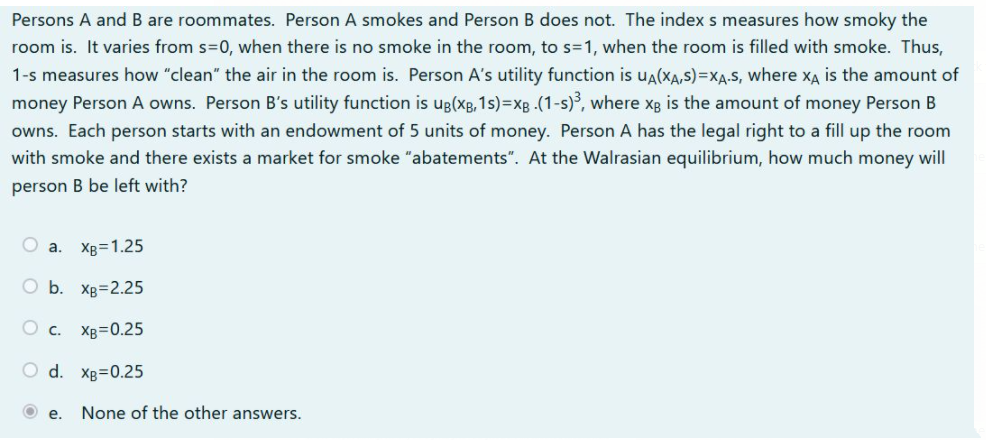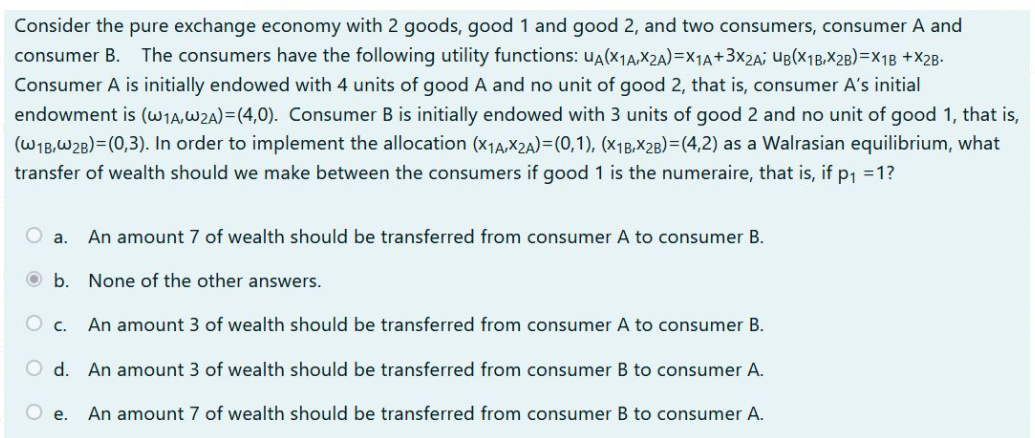Persons A and B are roommates. Person A smokes and Person B does not. The index s measures how smoky the room is. It varies from s=0, when there is no smoke in the room, to s=1, when the room is filled with smoke. Thus, 1-s measures how "clean" the air in the room is. Person A's utility function is ua(Xa,S)=Xa.S, where xa is the amount of money Person A owns. Person B's utility function is ug(xg,1s)=xg .(1-s)³, where xg is the amount of money Person B owns. Each person starts with an endowment of 5 units of money. Person A has the legal right to a fill up the room with smoke and there exists a market for smoke "abatements". At the Walrasian equilibrium, how much money will person B be left with? O a. Xg=1.25 O b. Xg=2.25 Ос. Хв3D0.25 O d. Xg=0.25 е. None of the other answers.
Persons A and B are roommates. Person A smokes and Person B does not. The index s measures how smoky the room is. It varies from s=0, when there is no smoke in the room, to s=1, when the room is filled with smoke. Thus, 1-s measures how "clean" the air in the room is. Person A's utility function is ua(Xa,S)=Xa.S, where xa is the amount of money Person A owns. Person B's utility function is ug(xg,1s)=xg .(1-s)³, where xg is the amount of money Person B owns. Each person starts with an endowment of 5 units of money. Person A has the legal right to a fill up the room with smoke and there exists a market for smoke "abatements". At the Walrasian equilibrium, how much money will person B be left with? O a. Xg=1.25 O b. Xg=2.25 Ос. Хв3D0.25 O d. Xg=0.25 е. None of the other answers.
Chapter8: Game Theory
Section: Chapter Questions
Problem 8.12P
Related questions
Question

Transcribed Image Text:Persons A and B are roommates. Person A smokes and Person B does not. The index s measures how smoky the
room is. It varies from s=0, when there is no smoke in the room, to s=1, when the room is filled with smoke. Thus,
1-s measures how "clean" the air in the room is. Person A's utility function is ua(XA,S)=XA.S, where xĄ is the amount of
money Person A owns. Person B's utility function is ug(xg, 1s)=xB .(1-s), where xg is the amount of money Person B
owns. Each person starts with an endowment of 5 units of money. Person A has the legal right to a fill up the room
with smoke and there exists a market for smoke "abatements". At the Walrasian equilibrium, how much money will
person B be left with?
O a. Xg=1.25
O b. Xp=2.25
O c.
XB=0.25
O d. Xg=0.25
е.
None of the other answers.

Transcribed Image Text:Consider the pure exchange economy with 2 goods, good 1 and good 2, and two consumers, consumer A and
consumer B. The consumers have the following utility functions: uA(X1A,X2A)=X1A+3x2A; UB(X1B,X2B)=X1B +X28.
Consumer A is initially endowed with 4 units of good A and no unit of good 2, that is, consumer A's initial
endowment is (W1A,W2A)=(4,0). Consumer B is initially endowed with 3 units of good 2 and no unit of good 1, that is,
(W1B,W2B)=(0,3). In order to implement the allocation (x14,X2A)=(0,1), (x1B,X2B)=(4,2) as a Walrasian equilibrium, what
transfer of wealth should we make between the consumers if good 1 is the numeraire, that is, if p1 =1?
O a.
An amount 7 of wealth should be transferred from consumer A to consumer B.
O b. None of the other answers.
O c.
An amount 3 of wealth should be transferred from consumer A to consumer B.
d. An amount 3 of wealth should be transferred from consumer B to consumer A.
O e.
An amount 7 of wealth should be transferred from consumer B to consumer A.
Expert Solution
This question has been solved!
Explore an expertly crafted, step-by-step solution for a thorough understanding of key concepts.
Step by step
Solved in 2 steps

Knowledge Booster
Learn more about
Need a deep-dive on the concept behind this application? Look no further. Learn more about this topic, economics and related others by exploring similar questions and additional content below.Recommended textbooks for you

